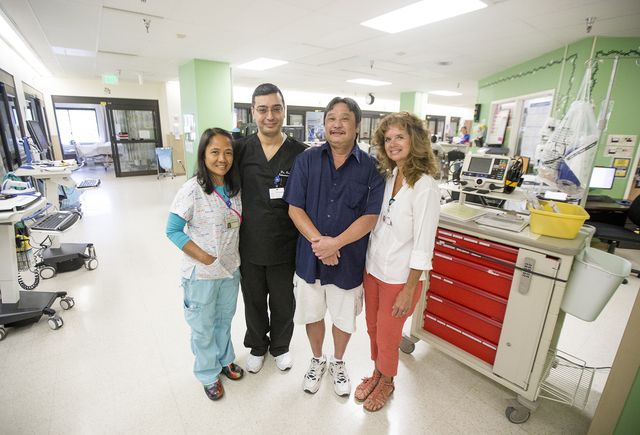One of the earliest memories Stephen Wong has after regaining consciousness at Hilo Medical Center on March 6, 2014, is of his doctor, Mouhamed Kannass. ADVERTISING One of the earliest memories Stephen Wong has after regaining consciousness at Hilo Medical
One of the earliest memories Stephen Wong has after regaining consciousness at Hilo Medical Center on March 6, 2014, is of his doctor, Mouhamed Kannass.
“He was sitting next to me, teaching me how to breathe again, for two hours,” Wong said incredulously. “‘Breathe in, like you’re smelling roses, breathe out, like you’re blowing out a birthday cake,’ he was telling me.”
Just a few weeks before, Wong had been a physically fit, 57-year-old kickboxing coach from the Hawaiian Beaches subdivision. A smoker at the time, Wong had been wrestling with the flu, which then turned into pneumonia.
He was terribly ill, but never visited his doctor. He says he doesn’t remember anything after a visit to a friend’s house on Valentine’s Day, 2014. A week later, according to his wife Joanne, he collapsed and the family called 911.
Upon Wong’s arrival at the hospital’s Emergency Room, nurses tested his vital signs and asked about his symptoms. They quickly ascertained that he most likely was suffering from a serious condition known as sepsis — a bacterial infection which spreads into the blood stream and throughout the body. It’s a condition that is so serious, it can kill in as little as 24 hours after an initial injury, Kannass said.
“You have a limited time frame,” he said. “For every hour that you delay treatment, the risk of death goes up 10-15 percent,” he said.
Luckily for Wong, and for the dozens of other patients who arrive at Hilo Medical Center in various stages of the infection, the hospital has made a big push since 2008 to lower its mortality rates due to sepsis. Now, that effort is evident in a sepsis care performance assessment released by the hospital this week. The assessment looks at data collected between June 1, 2013, and May 31, 2014.
Performed by health-care consultant Premier Inc., the assessment shows that the Hilo Medical Center’s patient outcomes in cases of severe sepsis and septic shock — the two most serious stages of the blood infection — put the hospital among the top performers in a group of 671 acute-care facilities across the country.
The death rate for patients arriving in the Hilo Medical Center ER with a case of severe sepsis was 7.6 percent, well below the average of 9.1 percent at top-performing hospitals across the country. Meanwhile, 20.3 percent of patients arriving in the ER in septic shock died, compared with an average of 23.1 percent among top performers.
Nationally, sepsis kills more than 258,000 people per year, and leaves thousands of survivors with life-changing after effects, according to the Centers for Disease Control and Prevention.
The insidious thing about it is that it is an “equal opportunity disease,” affecting young and old, male and female, said HMC Chief Nurse Officer Arthur Sampaga Jr. It can start with any kind of infection, be it a cut on your arm, or an infection of the lungs, like pneumonia. The infection can spread throughout the body, shutting down organs and doing damage to muscle and tissue.
The new results show, however, that the hospital’s work to improve its sepsis response has paid off, with fewer patients dying and shorter recuperation times for the many patients who survive but are left with a difficult recovery.
For Wong, that recovery took about 11 months, and he’s still working every day to get back to the quality of life he had before his infection.
“I’ve been working hard. I started out, I couldn’t even hold a small can (6 ounces) of tomato paste over the table. I just couldn’t hold it,” he said.
Now, he can walk several miles a day, and he’s even quit smoking, instead turning into “one of those annoying people” who tells everyone he sees smoking to stop.
The reason, he said, is simple.
“Every day, I get up, and the sun is shining, and the birds are singing. Now, I cherish every minute,” he said.
Kannass said that he and other members of the medical team at HMC hope that patients like Wong will continue to spread the word in the community, because even though the hospital has made big strides in caring for sepsis patients, it can’t work miracles.
“If you come to me too sick, and too late, I can do my best, but I’m only human,” he said.
In the case of Wong, for example, Kannass says that if he had come to the hospital within a couple days of getting pneumonia, he could have been treated and released after a week. Early detection is key to not only saving lives, but saving money and time, he said.
This month is Sepsis Awareness Month, and HMC employees have worked to spread the word that members of the community should keep a look out for the warning signs of sepsis and not be afraid to see a doctor immediately if they think they have an infection.
A few weeks ago, HMC’s Intensive Care Unit nurses banded together to film a music video featuring a warning about sepsis in the form of a parody of the song “Worth It” by 5th Harmony. The video can be found at www.naleo.tv/sepsis-music-video/.
Email Colin M. Stewart at cstewart@hawaiitribune-herald.com.
———-
Symptoms of sepsis include:
Source of infection
Elevated temperature > 101 degrees F
Pulse racing
Sleepy or confused
Immobility, weakness
Short of breath, rapid breathing
——————
What can you do to prevent sepsis?
- Get vaccinated
- Prevent infections that can lead to sepsis by cleaning scrapes and wounds and practicing good hygiene
- If you have an infection, look for signs like fever, chills, rapid breathing and heart rate, rash, confusion, and disorientation.



